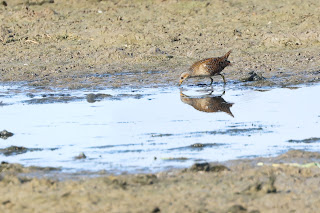All the wonderful birds and wildlife of Lancashire, Cheshire, North Wales and further
29/08/2022 The Audenshaw Reservoirs, Manchester
Dunlin: The pec was closely associating with a single dunlin on No.1 Res. Feeding along the newley exposed rocky spits that have been revealed as the water level continued to drop.
Dunlin & Pec Sand: I've never seen the water so low here, its crazy. Its so low on No.1 Res that there is vegetation growing in the basin of the reservoir, but this makes for some great birding habitat and looks great at the moment.
27/08/2022 Recar, Cleveland
When I arrived there were already a large crowed gathered along the beach watching the bird. The bird was feeding along the tide line and even picking at the washed up kelp.
Compared to its native cousins the ringed plover the greater sand plover has a thick-bill, long-legs and papers to be chunkier in appearance. They also posses grey backs and white underparts. The breast, forehead and nape are chestnut, and there they have a distictive black eye mask.25/08/2022 North Cave Wetlands, East Riding of Yorkshire
Brown Hawker (male): I'm having a little bit of a love affair with dragonflies at the moment, so having been working right next to North Cave Wetlands I just had to go and tick brown hawker.
I spent hours here, North Cave is a great little place, a patchwork of habitats is key with deep lakes, wet grassland, gravel islands, reedbed and hedgerows perfect for dragons.
Migrant Hawker (male & female): The circular walk around the main lakes lead to patches of reeds where the the skies were teaming with dragons and damsels.
Common Darter (female): I could have spent hours here if it wasn't for the heat and the early arming catching upon me.
23/02/2022 Risley Moss Nature Reserve, Warrington
Unfortunately this species is scarce in Cheshire but they are doing very well at Risley Moss, you'll find them in abundance here.
If you want to see black darter here your best bet is to hard down to the boardwalk which takes you across what they have names the Mini Moss. Look out for the darters as they rest and recharge in the sun by bathing on the wooden fence which lines the walk way.
Common Darter: There are also plenty of male and female common darter along the fences and also plenty at the small pond at the back of the visitor centre.21/08/2022 St Aidan's RSPB
The bird was on Cattle Gate Pool, where it shared the muddy scrape with a wood sand, a couple of spoonbill, yellow wags and greenshank.
This starling sized birds resembles the water rail, but is smaller, has a much shorter beak, and is a more uniform olive brown in colouring, with white dots scattered all over its plumage.
Famous for being masters of concealment, these shy and elusive birds can be particularly hard to see amongst the reds and muddy edges of lakes, but not here.
This individual was happy coming out into the open and feeding along the muddy banks of a small pool, alongside the coots and waders.
Great to see.
20/08/2022 withal Moss, Shropshire
Its a great place for dragonflies and damselflies, but also birds. its funny actually as I've been working for days at a time in Shrewsbury (not too far from Wixhall) and while working in the area the bird news has been pretty quiet, then when the job finishes a quality bird turns up. Typical.
The Red-Backed Shrike's Latin name is Lanius collurio with Lanius coming from the Greek for butcher! As this species is known as the butcher bird due to its rather barbaric behaviour. It uses its sharp hooked beak and to tear its prey apart and will also impale its prey onto anything sharp, usually thorns or even barbed wire.
This bird definitely lived up to its name as it spent more of its time while I was there deep in a hawthorn hedge feeding on cached pre.
It appeared to be feeding on a small mammal, butchered and impaled on a thorn. Possibly a larder hidden deep in bush. Fascinating to watch it pick at the bones and remove flash while sticking it down on the thorns.07/08/2022 Grafham Water, Cambridgeshire
After photographing a wedding on the Saturday I was looking forward to a some local birding and a relaxing afternoon at home with the baby.
Instead once news broke and after a few frantic calls, texts and WhatsApps I was racing down the motorways and across to Grafham Water.
A subspecies of the Kelp gull, also known as the Cape gull (Larus dominicanus vetula) this bird should be summering in Southern Africa. The Cape gull superficially resembles our Great-black backed gull and is intermediate in size between these two species.
02/07/2022 Bwlch Nant Yr Arain, Aberystwyth
This week I have taken some work in Shrewsbury, and was situated around an hour and a half away from the black kite, so I thought id try my luck and waited until 3pm when the feeding starts.








































